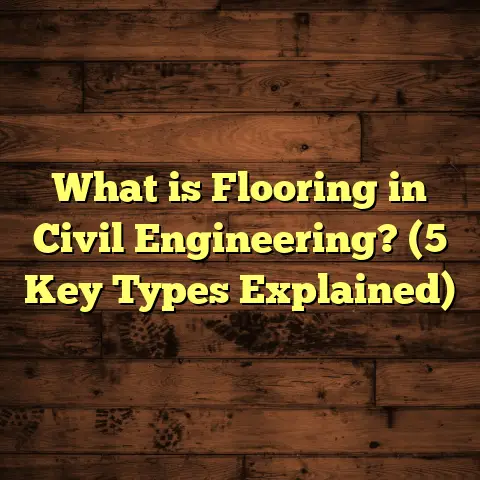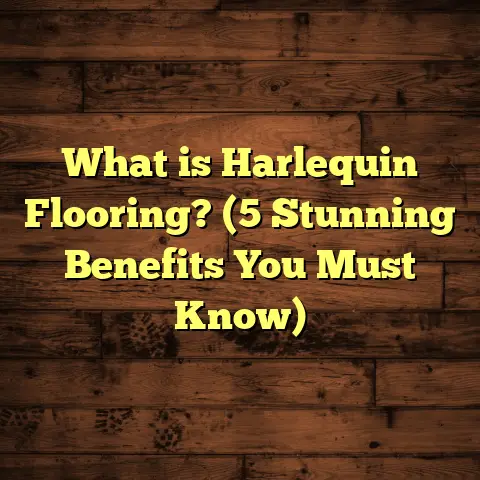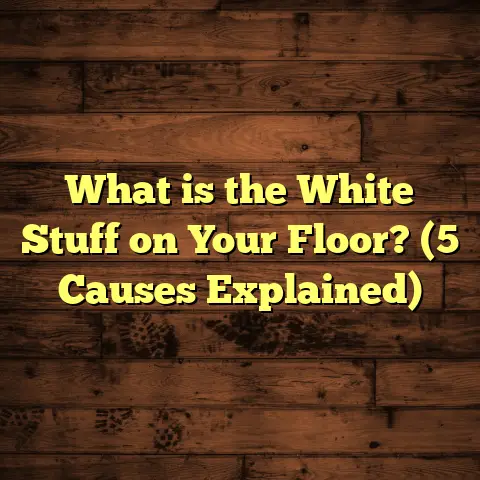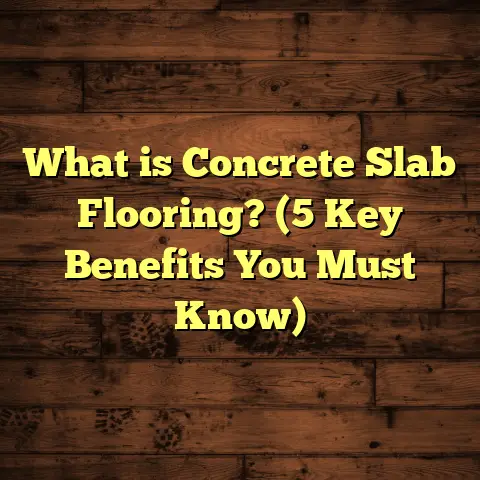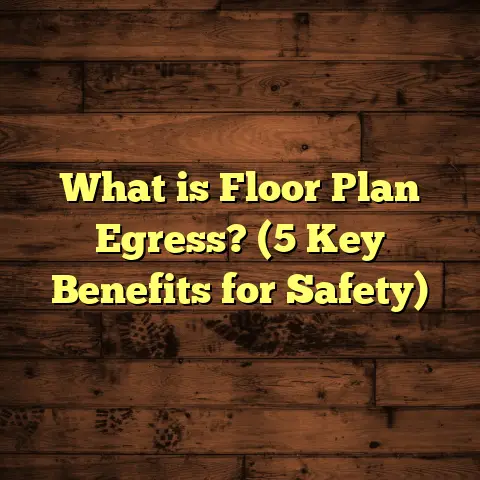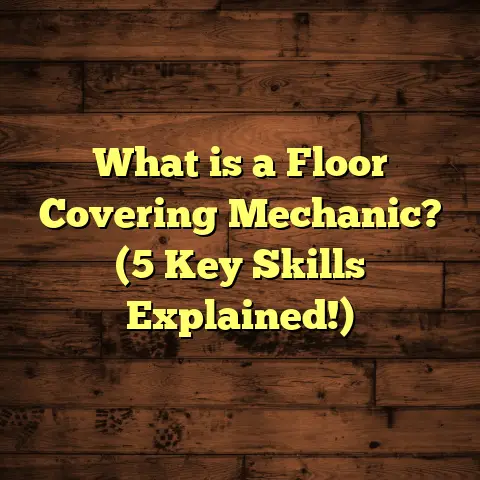What is a Floating Vinyl Floor? (5 Must-Know Benefits!)
I still remember the day I first installed a floating vinyl floor in my own home. Honestly, I was a bit skeptical at first—would it really hold up? Would it look good? Would it be worth the investment? After years of living with it, I can tell you confidently that it’s one of the best flooring choices I’ve ever made. Floating vinyl floors have this amazing way of combining style, durability, and ease that’s hard to beat. If you’ve ever wondered what exactly a floating vinyl floor is or why it might be the perfect fit for your space, pull up a chair and let me share everything I’ve learned.
What Is a Floating Vinyl Floor?
So, what is a floating vinyl floor? At its core, a floating vinyl floor is a type of resilient flooring made from synthetic materials that “floats” above your subfloor. This means the planks or tiles are not glued or nailed down directly to the floor beneath. Instead, they are connected to each other through an interlocking system, forming a stable surface that rests on top of the subfloor.
The term “vinyl” refers to the material used—mostly polyvinyl chloride (PVC). Vinyl flooring has been around for decades because of its water resistance, affordability, and ability to mimic natural materials like wood or stone. When combined with the floating installation method, you get a floor that’s easy to install, repair, and maintain.
How Does Floating Vinyl Flooring Work?
Floating vinyl floors use a click-lock system where each plank or tile has grooves and tongues on the edges that snap together. This interlocking creates a continuous surface without needing glue or nails. The entire floor “floats” over the subfloor rather than being fixed to it.
From personal experience installing these floors in various rooms—from kitchens to basements—I quickly realized how forgiving this design is. Need to replace one plank? Just unlock it without tearing up the whole floor. That kind of flexibility is rare with other flooring types.
Floating vs. Glue-Down Vinyl Floors
You might be wondering how floating vinyl compares to traditional glue-down vinyl options. Glue-down vinyl requires adhesive applied directly to the subfloor. This can make installation more complex and time-consuming. It also makes repairs harder since planks or tiles are fixed in place.
Floating vinyl floors eliminate the need for messy glue and drying times. Plus, because they’re not permanently attached, they can be removed or replaced more easily if needed. For homeowners looking for DIY-friendly options or rental properties where permanent alterations aren’t allowed, floating vinyl is a fantastic choice.
5 Must-Know Benefits of Floating Vinyl Floors
Over the years, I’ve worked on countless flooring projects. Floating vinyl floors always stand out for several reasons. Here are five benefits that truly make this flooring option worth considering.
1. Simple and Quick Installation
When I first started working with floating vinyl floors, I was surprised by how much time they save compared to other options like hardwood or ceramic tile. The click-lock system means you don’t have to mess around with nails, glue, or expensive tools.
In fact, most DIY enthusiasts can handle installation over a single weekend if they have basic carpentry skills. This can save hundreds or even thousands of dollars compared to professional installations.
Here’s some real data: According to the National Wood Flooring Association (NWFA), floating vinyl floors can be installed 30–50% faster than glued-down vinyl sheets or hardwood planks. This speed translates into lower labor costs if you hire professionals and less disruption if you’re doing it yourself.
Plus, because there’s no glue, you don’t have to wait for drying times before walking on the floor. That means faster project completion overall.
My Installation Experience
When I installed floating vinyl floors in my own kitchen, the process took just two days from start to finish—even though I was learning as I went along. I didn’t need any special tools beyond a saw and tapping block. The most time-consuming part was acclimating the planks to room temperature before installation.
If you’re comfortable with basic home improvement tasks, installing floating vinyl floors yourself is definitely doable.
2. Water and Moisture Resistance
This benefit is a game-changer if you have kids, pets, or live in a humid climate. Vinyl itself is naturally waterproof since it’s made from PVC. When combined with the floating design—which sits above the subfloor without direct contact—water damage becomes far less of an issue.
Hardwood floors can warp or swell when exposed to moisture, but floating vinyl floors resist stains, water damage, and mold growth much better.
In my own kitchen and bathroom renovations, I’ve seen floating vinyl floors outperform other flooring types by lasting longer without staining or bubbling—despite frequent spills and splashes.
Industry data supports this too: A 2022 report by the Resilient Floor Covering Institute (RFCI) showed that water-resistant vinyl reduces maintenance calls in kitchens and bathrooms by up to 40% compared to hardwood or laminate floors.
Basement Success Story
One client who used to worry about basement flooding found peace of mind after installing floating vinyl floors there. The waterproof nature meant occasional moisture didn’t ruin their flooring investment—a problem they’d faced repeatedly with carpet before.
3. Comfort Underfoot
If you’ve ever walked barefoot on cold tile or hard hardwood, you know how uncomfortable that can be—especially during winter mornings! Floating vinyl floors come with built-in underlayment layers or padding that provide a softer feel when you walk on them.
This cushioning not only makes standing or walking more pleasant but also helps reduce sound transmission throughout your home.
My family often remarks on how comfortable our living room floor feels after switching to floating vinyl compared to older laminate flooring we had before. Plus, this padding helps reduce noise—no more annoying creaks or echoes bouncing around the house.
What About Heating?
If you want radiant heating under your floor, floating vinyl works well with low-temperature systems because it doesn’t trap heat like carpet does. Just make sure your product is compatible with underfloor heating by checking manufacturer specs.
4. A Wide Range of Design Options
One thing I love about floating vinyl floors is the sheer variety available today. Whether you want the look of rustic oak, sleek marble, colorful geometric patterns, or even distressed barn wood—manufacturers have designed vinyl planks and tiles to mimic just about every natural surface imaginable.
Recent market research shows over 60% of homeowners choose vinyl flooring specifically for its design versatility.
For me personally, this meant I could pick styles that matched my aesthetic without breaking the bank. I remember choosing a dark walnut look for my dining room that gives all the warmth of hardwood but costs less than half as much.
Here’s some more insight: Advances in printing technology allow manufacturers to create ultra-realistic textures and colors that are hard to distinguish from real wood or stone—even up close.
5. Durability and Low Maintenance
Vinyl floors are tough—they resist scratches, dents, stains, and fading better than many hardwoods or laminates. Coupled with the floating installation method that reduces stress on individual planks by allowing slight movement, these floors tend to last a long time even in high-traffic areas.
From personal experience and customer feedback over the years, floating vinyl floors often maintain their appearance for 10–20 years with just simple cleaning routines.
A survey by HomeAdvisor found that 75% of users rated vinyl flooring’s durability as “excellent” or “very good,” especially when compared against carpet and laminate in busy households.
Breaking Down Floating Vinyl Flooring Features
Let’s explore some technical details that explain why floating vinyl floors perform so well.
Construction Layers Explained
A typical floating vinyl plank has several layers:
- Wear Layer: The top protective coating guards against scratches and stains.
- Printed Design Layer: The layer beneath shows off wood grain or stone look.
- Core Layer: Usually made from PVC composite or limestone-enhanced material; provides stability.
- Backing Layer: Offers moisture protection and adds support.
- Attached Underlayment: Some planks include this for added comfort and soundproofing.
Each layer plays a vital role in durability and comfort.
Why Thickness Matters
Thickness varies from about 2mm up to 8mm or more. Thicker planks typically feel sturdier underfoot and provide better insulation but can cost more upfront.
In one project I managed recently for a client’s family room addition, we chose 5mm thick planks as a balance between budget and comfort. The client was very happy with how solid the floor felt underfoot without spending too much.
Environmental Impact: What You Should Know
Vinyl flooring historically got a bad rap due to concerns over chemicals used during manufacturing and potential off-gassing indoors. However, modern production methods have improved dramatically.
Many brands now offer low-VOC (volatile organic compounds) products certified by organizations like FloorScore or GREENGUARD Gold.
If indoor air quality matters to you—as it should—you can find floating vinyl options that meet strict environmental safety standards.
Personally, I always recommend clients check for certifications before buying any resilient flooring product.
Real-Life Case Study: My Client’s Kitchen Makeover
Last year, I helped a client redo their kitchen floor using floating vinyl planks. The old tile was cracked and cold—definitely not kid-friendly. They wanted something warm-looking but durable enough for spills and heavy foot traffic.
We picked a wood-look vinyl plank with a thick core and attached underlayment for comfort. Installation took just two days—half what similar tile work would require—and they didn’t have to leave their home during that time.
After six months, the client reported zero issues with water damage despite frequent cooking accidents and spilled drinks. They also appreciated how quiet their kitchen felt compared to before.
The family said their kitchen felt “warmer” and “more inviting,” which made hosting dinners more enjoyable—a big win!
What About Cost? Budgeting Floating Vinyl Floors
Cost is often one of the first questions I get asked when discussing flooring options.
Prices vary depending on quality, thickness, brand reputation, and design complexity but here’s what you can generally expect:
- Material Costs: $2–$7 per square foot
- Installation Costs (if hired): $1–$3 per square foot
- DIY Installation: Potentially zero labor cost but factor in tools/time
Comparatively, hardwood flooring can cost $8–$15 per square foot installed; tile tends to run $5–$10 per square foot plus labor; carpet generally falls between $3–$6 per square foot installed.
So floating vinyl offers great value for money—especially when factoring in durability and ease of maintenance over time.
If you want precise estimates tailored for your project size and location, tools like FloorTally can be helpful for calculating total costs including materials, labor rates, waste factor, etc.
Installation Insights: Pro Tips From My Experience
Having installed many floating vinyl floors myself and trained others too, here are some pointers that make installation smoother:
- Acclimate Planks: Let flooring sit in the room for 48 hours before installation so it adjusts to temperature/humidity.
- Prepare Subfloor: Ensure surface is clean, dry, level within 3/16 inch over 10 feet.
- Use Spacers: Leave expansion gaps around room edges (usually 1/4 inch) for natural movement.
- Cut Carefully: Use a sharp utility knife for straight cuts; jigsaw may be needed for curves.
- Tap Gently: Use tapping blocks and mallets to lock planks without damage.
- Check Manufacturer Instructions: Every product has specific guidelines—follow them closely!
Following these steps helped me avoid common issues like gaps between planks or squeaky floors later on.
Can You Install Floating Vinyl Over Radiant Heating?
Yes! Floating vinyl is compatible with most low-temperature radiant heating systems because it doesn’t trap heat like some carpet types do.
The key is choosing products rated for use over radiant heat by manufacturers—look for product specs indicating maximum temperature limits (usually around 85°F).
I installed floating vinyl over electric radiant mats in a bathroom remodel once; it worked perfectly without warping or damage after two winters of use.
Maintenance: Keep It Looking Great With Minimal Effort
One big advantage of floating vinyl floors is how easy they are to maintain:
- Sweep or Vacuum Regularly: Prevent dirt buildup that can scratch surface.
- Use Damp Mop: Avoid soaking water; use manufacturer-approved cleaners.
- Avoid Abrasive Tools: No steel wool or harsh scrubbing pads.
- Protect High-Traffic Areas: Use rugs or mats at entryways.
- Furniture Pads: Place felt pads under legs to prevent dents.
- Fix Damage Quickly: Thanks to snapping planks design, replacing damaged sections is simple.
This low-maintenance nature makes it perfect for busy households where convenience counts as much as looks.
Addressing Common Concerns People Have About Floating Vinyl Floors
I hear these questions often from clients thinking about making the switch:
Can you install it yourself?
Absolutely! Most floating vinyl floors are designed with DIYers in mind thanks to click-lock systems requiring minimal tools.
Is it noisy?
Thanks to built-in underlayment layers or attached padding, noise is usually minimal compared to laminate without padding or hardwood on concrete slab subfloors.
Does it feel cheap?
Not at all! Modern designs mimic wood grain texture closely so many guests don’t realize it’s vinyl until they touch it themselves.
Will it peel or bubble?
With proper installation (clean subfloor & acclimation), issues like peeling are rare since there’s no adhesive involved that can fail over time.
How long does it last?
Expect 10–20 years with normal wear; higher-end products last even longer when maintained well.
Is it safe for pets?
Yes! It resists scratching better than hardwood and is easy to clean after accidents.
Comparing Floating Vinyl Floors With Other Popular Flooring Options
It’s helpful to see how floating vinyl stacks up against other common flooring types:
| Flooring Type | Installation Difficulty | Water Resistance | Comfort | Durability | Cost per Sq Ft (Installed) | Design Variety |
|---|---|---|---|---|---|---|
| Floating Vinyl | Easy | Excellent | High | High | $3–$10 | Very High |
| Hardwood | Moderate | Poor | Moderate | Moderate | $8–$15 | High |
| Laminate | Moderate | Low/Moderate | Moderate | Moderate | $4–$8 | High |
| Ceramic Tile | Hard | Excellent | Low | Very High | $5–$12 | Moderate |
| Carpet | Easy | Poor | High | Low | $3–$6 | Moderate |
I’ve installed all these types over my career; floating vinyl strikes an excellent balance between performance and price for many homeowners’ needs.
Environmental Considerations: Sustainability & Recycling
Vinyl isn’t typically known as an eco-friendly material because it comes from petroleum-based sources. However:
- Some manufacturers are now producing recycled-content vinyl flooring.
- Programs exist for recycling old vinyl planks into new products.
- Choosing low-VOC certified products helps minimize indoor air pollution.
- Durable floors mean less frequent replacement reducing waste overall.
If sustainable materials matter most to you—but you still want practical waterproof flooring—some hybrid options blend natural fibers with resilient cores but at premium prices.
Final Thoughts From Someone Who’s Been There
Choosing flooring isn’t just about looks—it affects comfort, maintenance workload, budget, and how your home feels day-to-day. Over years of installing many products myself and working with clients on their homes:
Floating vinyl floors continuously impress me with their combination of beauty, durability, affordability, and ease of use.
Whether you want something easy enough to install yourself or need resilient surfaces for kitchens, basements, bathrooms—or anywhere prone to moisture—floating vinyl flooring deserves serious consideration.
If you want practical floors that don’t sacrifice style or comfort—and last long without headaches—this might just be your perfect match!
Have questions about specific brands? Need advice on installation? Curious about matching colors or textures? Drop me a line—I’m glad to share knowledge from years of hands-on experience!
